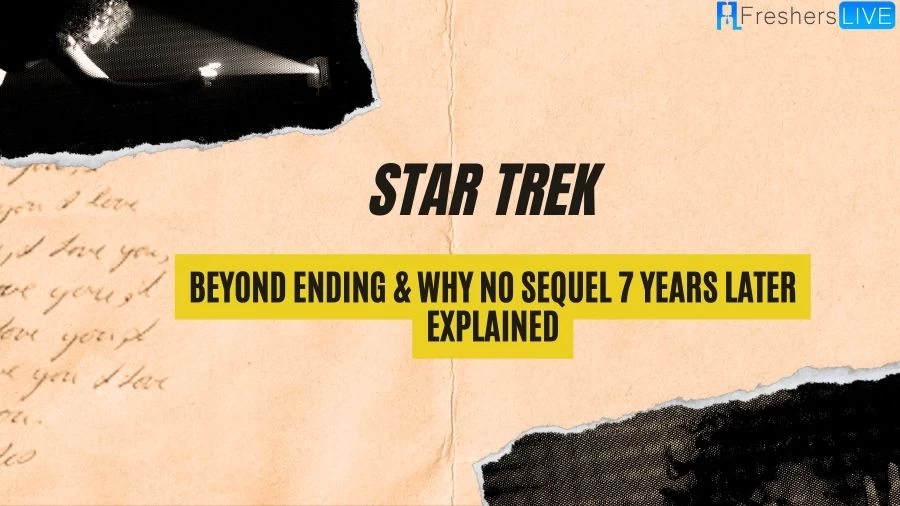Uncover Star Trek Beyond’s thrilling ending and uncover the mystery behind the lack of a sequel seven years later. Don’t miss the buzz – sign up for Fresherslive now! From breaking celebrity news to insightful movie reviews, be the first to know and participate in the ever-evolving entertainment scene at Fresherslive.
Star Trek Beyond Ending & Why No Sequel 7 Years Later Explained
Despite the possibility of more adventures for the crew Chris Pine’s Kelvin Timeline hinted at in the Star Trek: Beyond epilogue, it’s been seven years since the movie was released and Star Trek 4 has yet to materialize. In Star Trek Beyond, the third film produced by JJ Abrams, the crew of the USS Enterprise is stranded on the planet Altamid. There, they discover an ancient Starfleet ship, revealing that Krall and his army are the mutant crew of the USS Franklin. Seeking revenge on the Federation since their fall in Altamid, Krall’s plan goes on for decades.
While Kirk and Spock ponder their future in the events of Star Trek Beyond, the film doesn’t indicate that it marks the end of the Kelvin Timeline. Captain Kirk loses faith in his five-year mission and applies for the position of Vice Admiral at a revolutionary space base called Yorktown. Meanwhile, the passing of Ambassador Spock (Leonard Nimoy) has made his younger self consider leaving Starfleet and pursuing Spock’s diplomacy on New Vulcan. However, as the events of the film unfold, both Kirk and Spock realize their place is on the USS Enterprise, uniting to continue their five-year mission.
Star Trek Beyond Ending & Why No Sequel 7 Years Later
The delay in bringing the Star Trek Beyond sequel to fruition can be attributed to a variety of factors, two of which stand out. First, there may have been a dispute over salary and contract negotiations involving the cast and crew, especially considering the success of previous films and the growing popularity of some of the actors. Remuneration negotiations and other contractual issues can sometimes be complicated and time consuming, leading to delays in project progress.
Second, the desire to compete with the ever-expanding universe of Marvel blockbusters could play an important role. The Marvel Cinematic Universe (MCU) has dominated the box office, capturing audiences worldwide with its interconnected stories and epic spectacle. As studios aim to secure their spot in the highly competitive entertainment industry, they may have chosen to carefully strategize and plan the release of a new Star Trek movie to maximize its chances of success amid Marvel’s massive releases.
interstellar travel
Star Trek, an American science fiction media franchise created by Gene Roddenberry, started with the iconic 1960s television series and quickly became a global pop culture craze. Since then, it has expanded into movies, TV series, video games, novels and comics, becoming one of the most popular and highest-grossing franchises of all time. The journey begins with Star Trek:
The original series, which follows the adventures of the crew of the USS Enterprise as they explore new worlds and civilizations in the 23rd century. The success of the franchise has led to a spin-off series, a movie, and a recent reboot called The Kelvin Timeline. Star Trek has a fan base of its own, known as “Trekkies” or “Trekkers,” and has made a significant cultural impact, promoting civil rights and showcasing a diverse cast in its early days on U.S. television.
https://www.youtube.com/embed/iGAHnZ555nI
Star Trek Conception and Setting
In 1964, Gene Roddenberry conceived the idea for a sci-fi series that would eventually become Star Trek. While he’s openly presented it as a Western space resembling “Wagon Train to the Stars,” he personally sees it as inspired by Jonathan Swift’s Gulliver’s Travels, with the intention of weaving suspenseful adventures with moral lessons. The series primarily revolves around humans and aliens serving in Starfleet, the peacekeeping and humanitarian force of the United Planets Federation, embodying selfless values in the face of challenging dilemmas.
Star Trek stories often serve as allegories for contemporary cultural issues. The original series tackled 1960s concerns, while the sequels tackled relevant issues of their respective eras. These topics include war, loyalty, authoritarianism, imperialism, class conflict, economics, racism, religion, human rights, sexism, feminism, and the impact of technology. Roddenberry used this futuristic setting to tackle provocative topics such as sex, politics and Vietnam, often passing such messages through internet censors under the guise of alien themes.
Disclaimer: The above information is for general information purposes only. All information on the Website is provided in good faith, however we make no representations or warranties of any kind, express or implied, as to the accuracy, completeness, validity, reliability, availability or completeness of any information on the Website.
Let the article source Star Trek Beyond Ending & Why No Sequel 7 Years Later Explained of website nyse.edu.vn
Categories: Entertainment
